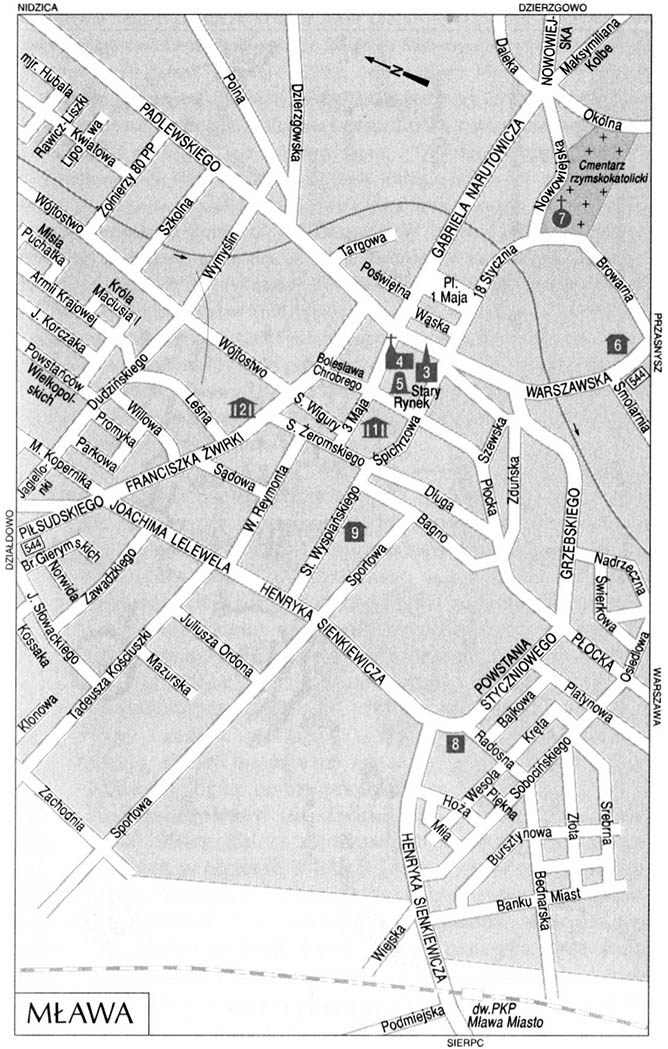 MŁAWA – 1. Museum of Zawkrzeńska Region 2. The Juszkiewicz Museum 3. Town hall 4. Church of the Holy Trinity Church 5. Monument to St. Wojciech 6. Wooden granary "Letewetówka" 7. St. George's Chapel. Lawrence 8. Mound commemorating the insurgents 1863 r. 9. High School for them. S. Wyspiański
MŁAWA – 1. Museum of Zawkrzeńska Region 2. The Juszkiewicz Museum 3. Town hall 4. Church of the Holy Trinity Church 5. Monument to St. Wojciech 6. Wooden granary "Letewetówka" 7. St. George's Chapel. Lawrence 8. Mound commemorating the insurgents 1863 r. 9. High School for them. S. Wyspiański
A town in the Mławskie Hills, on the Mławka river, ok. 30500 inhabitant. The seat of the municipal office. From 1999 r. county town. Traffic cord (a large railway station on the Warsaw-Gdańsk line), industrial center (Friesland Dairy, meat plants, shoe factory, Curtis TV set). The Society of Lovers of the Mława Region and 3 museums.
City founded in 1429 r. on the so-called. raw root, ok. 5 km to the south. east. from the existing one (before 1413 r.) settlements. City rights were established by a privilege issued by the then jointly ruling sons of the Duke of Mazovia, Siemowit IV: Siemowit V, Casimir II and Władysław I. The privileges granted made it possible to have scales and to cut cloth. The city was an important border center with a customs house in this part of Mazovia. W XV-XVI w. it was famous for its crafts and wood trade, cattle, horses, wax and honey. W 1435 r. under the Polish treaty–of the Teutonic Order from Brześć Kujawski, a border court was established in Mława to resolve complaints from both parties. Probably from 1495 r. seat of the non-town starosty. W 1 half. 17th century. was one of the largest cities in Mazovia and had approx. 2500 inhabitant. During this period, it was also famous for the production of beer. During the Swedish invasion, Mława was destroyed, which started a long period of regression. W 1764 r. the city became the seat of the castle starosty. W 1793 r. a provincial assembly was held here as the city was the only one free from Prussian troops. From 1795 r. found itself in the Prussian partition. W 1806 r. there was a battle of Prussian troops in the area of the city, commanded by gen. Call, with French troops, headed by Gen.. Marchaud. In years 1807-15 city in the Duchy of Warsaw. W 1812 r. French troops passed through Mława again. In years 1815-1918 Mława was incorporated into the Kingdom of Poland.
Thanks to the location of customs chambers here and in the nearby Pepłówek, the city revived economically. Brickyards were built, tanneries, mills, oil mill, brewery, vinegar and soap factories. W 1856 r. a hospital of St.. Wojciech. In the same year, a synagogue was built. W 1856 a beaten track was built (hardened) from Mława to Nidzica (later extended to Konigsberg). W 1870 r. the German population built an Evangelical church, a w 1879 r. tsarist authorities built an Orthodox church. W 1877 r. launched the so-called. the Vistula railway line to Warsaw.
19 of August 1887 r. Mława was visited by the writer Bolesław Prus, to see a solar eclipse from here, which had its literary counterpart in the depiction of the Egyptian solar eclipse described in "Pharaoh".
At the turn of the 19th and 20th centuries,. the city became the cultural and economic center of the North. Mazovia. Number of inhab. with 2200 w 1825 r. rose to 17 500 w 1910 r. At the beginning. In World War I, Mława was seriously damaged.
W 1915 r. was connected by a narrow-gauge railway (about the wheelbase 600 mm, as amended in 1961 r. on 750 mm) with Przasnysz (currently only freight and tourist courses). The queue was built by the Germans in less than one 3 months for strategic purposes.
